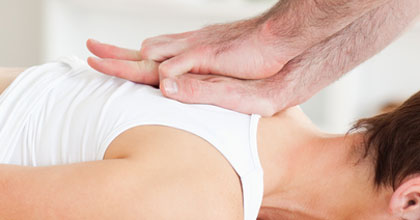
Thoracic / Upper Back Pain
Pain in the upper back, ribcage or shoulder blade area is often termed ‘thoracic’ pain. It can be frustrating and cause problems with movement, coughing and sneezing, or sitting and standing still for sustained periods of time. Hands on treatment and specific rehabilitation and retraining are often very effective at improving thoracic pain.
The thoracic spine is made up of 12 vertebral bones and the discs in between them, and each pair of 12 ribs attach onto the thoracic vertebrae. The thoracic spine and its discs cover the greatest area of your back and enclose the main organs in the body. It is important for protecting and preventing compression of the heart, lungs and major blood vessels, and absorbing energy through the ribcage to protect you if you fall.
• Kyphosis – this is a term that relates to the curvature in this part of the spine. We should all have a kyphosis or mildly rounded position in this part of our backs. A more sedentary lifestyle often leads to more time in this flexed/bent over posture and can cause an increase in the curve pain.
• Scoliosis – in simple terms this looks like a sideways curve in the spine when looking from behind at someone’s back. Contrary to what some clinicians say, asymmetry is totally normal; no-one is completely symmetrical. The curve can vary from a mild one which is normal and shouldn’t cause you any problems, to a severe one which needs active management. If you are an adult it is very unlikely that you need any surgical intervention.
Contributing factors to thoracic/upper back pain:
• Posture – this is usually habitual and change is normally about mental reconditioning yourself to a more neutral sitting or standing position. Posture has the greatest effect us when we are still in sustained resting positions rather than when we are moving.
• Muscle imbalance – physical training can lead to imbalances in the muscle groups in the upper part of the torso. A typical example would be someone who has done too much bench press in the gym leading to strong but tight and short pectoral muscles which often pulls the person into a more flexed position.
• Joint stiffness – All the joints in your body should be able move in all the directions that they are meant to easily. They will only do this if regularly taken through those full ranges of motion. In this region the problem is often a restriction into extending or arching backwards. This can come about as a result of repeated slumped sitting.
• Muscle tightness – All the muscles in your body should be able to be stretched out without causing pain or restriction. If they cannot lengthen properly this can lead to pain.
